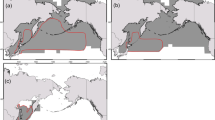Abstract
Since 1987, millions of juvenile salmonids (smolts; Oncorhynchus species) in the Snake and upper Columbia rivers have been tagged with Passive Integrated Transponder (PIT) tags, and detected at hydroelectric projects as theymigrate downriver to the Pacific Ocean. Since the late 1990s, detection of PIT-tagged adults has been possible at some dams. Existing release-recapture models are designed for either juvenile data or adult data, but not both.We present amigratory life-cycle release-recapture model that follows tagged individuals from their release as juveniles through their return migration as adults, accounting for downstream barge transportation of juveniles, right-censoring due to known removals at dams, and adult age at maturity. This branching model estimates river survival, age-specific probabilities of adult return, and relative effects of smolt transportation on survival. Performance measures are defined using model parameters. We analyze a dataset of 58,447 PIT-tagged summer Chinook salmon released in 2000 in the Snake River. For nontransported fish, juvenile survival from passage at Lower Granite Dam to Bonneville Dam was estimated at 60.3% (\(\widehat{SE} = 8.1\% \)), and the ocean return probability to Bonneville was estimated at 4.5% (\(\widehat{SE} = 0.7\% \)). The smolt-to-adult ratio (SAR) for the entire release group was estimated at 2.0% (\(\widehat{SE} = 0.09\% \)), and perceived inriver adult survival was estimated at 87.1% (\(\widehat{SE} = 1.7\% \)).
Similar content being viewed by others
References
Brownie, C., Hines, J. E., Nichols, J. D., Pollock, K. H., and Hestbeck, J. B. (1993), “Capture-Recapture Studies for Multiple Strata Including non-Markovian Transitions,” Biometrics, 49, 1173–1187.
Buchanan, R. A. (2005), “Release-Recapture Models for Migrating Juvenile and Adult Salmon in the Columbia and Snake Rivers Using PIT-Tag and Radiotelemetry Data,” PhD thesis, University of Washington, Seattle, WA.
Buchanan, R. A., Skalski, J. R., and Smith, S. G. (2006), “Estimating the Effects of Smolt Transportation from Different Vantage Points and Management Perspectives,” North American Journal of Fisheries Management, 26, 460–472.
Burnham, K. P. and Anderson, D. R. (2002), Model Selection and Multimodel Inference: A Practical Information-Theoretic Approach (2nd ed.), New York: Springer-Verlag.
Burnham, K. P., Anderson, D. R., White, G. C., Brownie, C., and Pollock, K. (1987), “Design and Analysis Methods for Fish Survival Experiments Based on Release-Recapture,” American Fisheries Society Monograph 5.
Carothers, A. D. (1973), “The Effects of Unequal Catchability on Jolly-Seber Estimates,” Biometrics, 29, 79–100.
— (1979), “Quantifying Unequal Catchability and Its Effect on Survival Estimates in an Actual Population,” Journal of Animal Ecology, 48, 863–869.
Chapman, D., Carlson, C., Weitkamp, D., Matthews, G., Stevenson, J., and Miller, M. (1997), “Homing in Sockeye and Chinook Salmon Transported around Part of Their Smolt Migration Route in the Columbia River,” North American Journal of Fisheries Management, 17, 101–113.
Clobert, J., Lebreton, J. D., Allaine, D., and Gaillard, J. M. (1994), “The Estimation of Age-Specific Breeding Probabilities from Recaptures or Resightings of Marked Animals. II Longitudinal Models,” Biometrics, 50, 375–387.
Cormack, R. M. (1964), “Estimates of Survival from the Sighting of Marked Animals,” Biometrika, 51, 429–438.
Jolly, G. M. (1965), “Explicit Estimates from Capture-Recapture Data with Both Death and Immigration — Stochastic Model,” Biometrika, 52, 225–247.
Lebreton, J.-D., Burnham, K. P., Clobert, J., and Anderson, D. R. (1992), “Modeling Survival and Testing Biological Hypotheses Using Marked Animals: A Unified Approach with Case Studies,” Ecological Monographs, 62, 67–118.
Lebreton, J.-D., Hines, J. E., Pradel, R., Nichols, J. D., and Spendelow, J. A. (2003), “Estimation by Capture-Recapture of Recruitment and Dispersal over Several Sites,” Oikos, 101, 253–264.
Muir, W. D., Smith, S. G., Williams, J. G., Hockersmith, E. E., and Skalski, J. R. (2001), “Survival Estimates for Migrant Yearling Chinook and Steelhead Tagged with Passive Integrated Transponders in the Lower Snake and Lower Columbia Rivers, 1993–1998,” North American Journal of Fisheries Management, 21, 269–282.
Pradel, R. and Lebreton, J.-D. (1999), “Comparison of Different Approaches to Study the Local Recruitment of Breeders,” Bird Study, 46 (supplement), 74–81.
Ricker, W. E. (1975), “Computation and Interpretation of Biological Statistics of Fish Populations,” Bulletin of the Fisheries Research Board of Canada, 191.
Sandford, B. P. and Smith, S. G. (2002), “Estimation of Smolt-to-Adult Return Percentages for Snake River Basin Anadromous Salmonids, 1990–1997,” Journal of Agricultural, Biological, and Environmental Statistics, 7, 243–263.
Seber, G. A. F. (1965), “A Note on the Multiple Recapture Census,” Biometrika, 52, 249–259.
— (1982), The Estimation of Animal Abundance and Related Parameters (2nd ed.), Caldwell, NJ: Blackburn Press.
Skalski, J. R. (1998), “Estimating Season-Wide Survival Rates of Outmigrating Salmon Smolt in the Snake River, Washington,” Canadian Journal of Fisheries and Aquatic Sciences, 55, 761–769.
Skalski, J. R., Smith, S. G., Iwamoto, R. N., Williams, J. G., and Hoffman, A. (1998), “Use of Passive Integrated Transponder Tags to Estimate Survival of Migrant Juvenile Salmonids in the Snake and Columbia Rivers,” Canadian Journal of Fisheries and Aquatic Sciences, 55, 1484–1493.
Smith, S.G., Muir, W.D., Hockersmith, E. E., Achord, S., Eppard, M. B., Ruehle, T. E., Williams, J. G., and Skalski, J. R. (1998), “Survival Estimates for the Passage of Juvenile Salmonids Through Snake River Dams and Reservoirs, 1996,” Technical Report contract 1993BP10891, project 199302900, Bonneville Power Administration, http://www.efw.bpa.gov/searchpublications.
Smith, S. G., Muir, W. D., Marsh, D., Williams, J., and Skalski, J. R. (2006), “Survival Estimates for the Passage of Spring-Migrating Juvenile Salmonids through Snake and Columbia River Dams and Reservoirs,” Technical Report contract 00004922, project 199302900, Bonneville Power Administration, http://www.efw.bpa.gov/searchpublications.
Zabel, R. W., Wagner, T., Congleton, J. L., Smith, S. G., and Williams, J. G. (2005), “Survival and Selection of Migrating Salmon from Capture-Recapture Models with Individual Traits,” Ecological Applications, 15, 1427–1439.
Author information
Authors and Affiliations
Corresponding author
Rights and permissions
About this article
Cite this article
Buchanan, R.A., Skalski, J.R. A migratory life-cycle release-recapture model for salmonid PIT-tag investigations. JABES 12, 325–345 (2007). https://doi.org/10.1198/108571107X229331
Received:
Revised:
Issue Date:
DOI: https://doi.org/10.1198/108571107X229331




